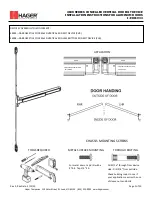
8
2.
Grate Cutting
- For rapid restarts, such as grate
or heavy mesh cutting, do not release the torch
switch. This avoids the 2 second pref-low por-
tion of the cutting cycle.
3.
Edge Starting
- For edge starts, hold the torch
perpendicular to the work piece with the front
of the tip near (not touching) the edge of the
work piece at the point where the cut is to start.
When starting at the edge of the plate, do not
pause at the edge and force the arc to ‘reach’ for
the edge of the metal.
NOTE:
The speeds given here are typical for best
quality cuts. Your actual speeds may vary depending
on material composition, surface condition, operator
technique, etc.
If cutting speed is too fast, you may lose the cut. With
slower speeds excessive dross may accumulate. If
speed is too slow, the arc may extinguish. Air cutting
typically produces a rough face on stainless steel and
aluminium.
Establish the Cutting Arc as Quickly
as Possible.
4. Drag Cutting
- Position torch tip slightly above
work piece, press torch switch and lower torch
tip forward work piece until contact is made
and cutting arc is established. After cutting arc
is established, move the torch in the desired
direction keeping the torch tip slightly angled,
maintaining contact with the work piece.
Avoid moving too fast as would be indicated by
sparks radiating from the topside of the work
piece. Move the torch just fast enough to main-
tain sparks concentration at the underside of
the work piece and making sure the material
is completely cut through before moving on.
Adjust drag speed as desired/ required.
Cutting Speed Guide
Material
Thickness Cutting Speed
(mm) (mm/s)
1.6
150
3.2
50
6.4
20
1.6
140
3.2
40
6.4
15
1.6
190
3.2
85
6.4
30
Stainless
Steel
(AISI 304)
Aluminium
(6061)
Carbon
Steel
(AISI 1020)
5.
Direction of Cut
- The plasma gas stream swirls
as it leaves the torch to maintain a smooth col-
umn of gas. This swirl effect results in one side
of a cut being more square than the other.
Viewed along the direction of travel, the right
side of the cut is more square than the left.
Left Side Cut Angle
Right Side Cut Angle
To make a square-edged cut along an inside diam-
eter of a circle, the torch should move counter clock-
wise around the circle. To keep the square edge along
an outside diameter cut, the torch should travel in a
clockwise direction.
6. Quality Cuts
– Dross (slag) is the excess material
that spatters and builds up on the underside of the
work-piece as you cut. Dross occurs when the oper-
ating procedure and technique is less than optimal.
It will require practice and experience to obtain cuts
Operating Techniques
1.
Piercing
- Materials (up to 3.2mm/1/8in. thick)
may be pierced with the torch touching the
work. When piercing thicker materials (up to
4.8mm stainless or carbon steel) at an angle,
position the torch 0.5mm (.02”) above the work
piece.
It is advisable when piercing thicker materials to
drill a small pilot/starting hole in the work piece
which makes it a lot easier and gives increased
tip life. Start the cutting arc, then immediately
raise the torch to 1.6mm (1/16”) stand-off and
move the torch along the cut path. This will re-
duce the chance of spatter from entering the
torch and prevent the possibility of welding
the tip to the plate. The torch should be angled
at about 30° when starting to pierce, and then
straightened after accomplishing the pierce.
Содержание WT40DC
Страница 1: ...OPERATING INSTRUCTIONS WT40DC 40A PLASMA CUTTER www weldtech net nz...
Страница 4: ...4...


































